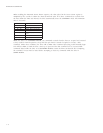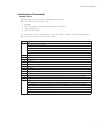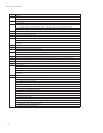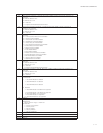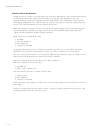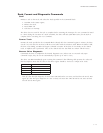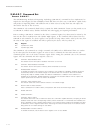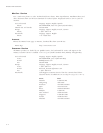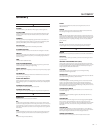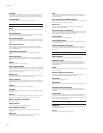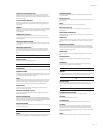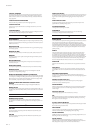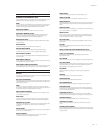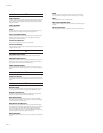
GLOSSARY
GL – 2
CYLINDER
On several disk surfaces sharing a common rotational axis, the aggregate of tracks at a
given radial position. A set of disk tracks that are simultaneously under the set of read/
write heads. This three-dimensional storage volume can be accessed after a single seek.
CYLINDER ZERO
The outermost cylinder in a drive that can be used for data storage.
D
DATA
An ordered collection of information. In a specific case, it is the information processed
by a computer.
DATA SEPARATOR
An electronic circuit which decodes playback data and produces separate clock and data
bits. Sometimes incorrectly used to denote data synchronizer.
DATA SYNCHRONIZER
An electronic circuit producing a clock signal that is synchronous with the incoming
data stream. This clock signal is then used to decode the recording code being used into
user data.
DATA TRANSFER RATE
In a disk or tape drive, the rate at which data is transferred to or from the storage
media. It is usually given in thousands of bits per second (Kbit/second) or millions of
bits per second (Mbit/second).
DEDICATED LANDING ZONE
A designated radial zone on the disk where contact starting and stopping occur by
design.
DEDICATED SERVO
A servo scheme in which a prerecorded pattern on an otherwise unused disk surface
provides position information to the servo circuitry by means of a head reading that
surface.
DEFECT
A magnetic imperfection in a recording surface.
DEFECT MANAGEMENT
A general methodology of avoiding data errors on a recording surface by avoiding the
use of known bad areas of media. Usually defective sectors or tracks are retired and data
are written in alternate locations. Several algorithms are possible such as “sector
slipping,” or “spare sector per track.”
DEFECT MAP
A list of defects that fall within a pass/fail criteria of a user. This list is usually used by an
operating system or a disk drive controller for defect management.
DEFECT SKIPPING
A defect management scheme for avoiding surface defects. It has data written before and
after the defect, instead of using alternate tracks or sectors to avoid use of the defective
area.
DENSITY
Generally, recording density. See areal, bit, and storage density.
DC ERASE
The method of erasing a track using a DC write/erase current through either a Read/
Write or Erase head.
DIGITAL
Any system that processes digital binary signals (having only values of a 1 or 0; usually
in bits and bytes) rather than analog signals (signals that can have many values)
DIGITAL MAGNETIC RECORDING
See magnetic recording.
DIRECT ACCESS
Access directly to memory location. (See random access).
DIRECT MEMORY ACCESS
A mean of data transfer between the device and host memory without processor
intervention.
DIRECTORY
A listing of files maintained by the disk operation system (DOS) or a data base
management system to enable a user to quickly access data files.
DISK
A flat, circular piece of metal (usually aluminum) or plastic (usually mylar) with a
magnetic coating upon which information can be recorded. (See, for example, floppy
disk or Winchester disk)
DISK DRIVE OR DISK MEMORY DEVICE
The total electromechanical storage device containing disks and read/write heads, head
positioning mechanism, drive motor, and electronics.
DISK PACK
A number of metal disks packaged in a canister for removal from the disk drive
(predecessor of Winchester technology).
DISK OPERATING SYSTEM (DOS)
The master computer system program that schedules tasks, allocates the computer system
resources, controls accesses to mass storage devices, manages files, and so forth. Typical
disk operating systems include CP/M, MS-DOS, and UNIX.
DISK STORAGE
Auxiliary memory system containing disk drives.
DISK TRANSFER RATE
The rate that digital data is transferred from one point to another. Expressed in either
bits/second or bytes/second.
DOUBLE FREQUENCY ENCODING
Another name for FM encoding. This is because all possible data combinations will
result in only two possible temporal displacements of adjacent data bits, specifically
“1F” and 2F.”
E
EARLY WINDOW
A data window that has been intentionally shifted in time in an early direction.
EMBEDDED SERVO
A servo technique used for track following. Position information is prerecorded
between data areas in a track so that a data head, and proper additional circuitry, can
determine the data head location with respect to the center position of the track (or
cylinder) in question.
ERASE
A process by which a signal recorded on a medium is removed and the medium made
ready for rerecording.
ERROR CORRECTION CODE (ECC)
A mathematical algorithm that can detect and correct errors in a data field. This is
accomplished with the aid of Check Bits added to the raw data.
ERROR FREE
A recording surface that has no defects.
ERROR RATE
The number of errors (type must be specified) that occur in a specified number of bits
read.
ERROR RECOVERY PROCEDURE
The process that occurs in response to a data error. In a drive without ECC, this
would include re-calibration and re-seeking to the specified track and rereading the
specified data.
EXTRA PULSE
Term used in surface certification. It is when a flux field discontinuity remains after the
recording surface is erased, thereby producing an electrical output of a read head
passing over the area with the discontinuity. An extra pulse occurs when the electrical
output is larger than a specified threshold.
F
FEEDBACK
In a closed-loop system, the output signal (from the servo head) is used to modify the
input signal (to the positioner).
FETCH
A read operation and its related data transfer operations.



